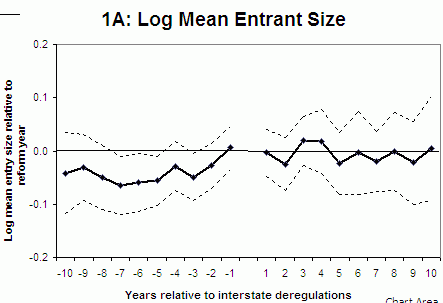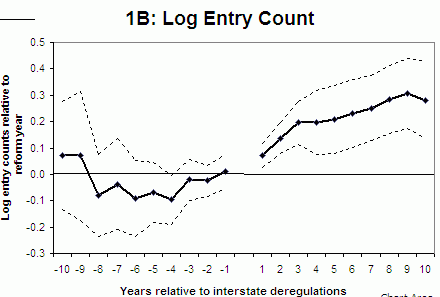The process of “creative destruction”, whereby entrepreneurs with new ideas and methods of production displace less efficient incumbents, is believed to play a critical role in driving productivity growth in the economy. High-profile entrepreneurs create and commercialise new technologies such as automobiles and semiconductors – major innovations that spawn new industries. Although clearly important, such start-ups only represent a tiny proportion of overall entry in the economy. Perhaps 0.1%-0.2% of US start-ups receive venture capital funding each year – the predominant source of finance for such high-growth ventures.
A less visible channel is the enhanced productivity growth arising from increased efficiency in existing methods of production. A substantial share of the productivity growth in the economy is believed to arise from through the birth of more productive firms and the closure of unproductive firms rather than just through existing firms becoming more productive. Foster et al. (2008) show the productivity advantages of new entrants in a variety of manufacturing industries, including traditional products such as concrete. A number of related studies further point to the vital role of this general entrepreneurship for economic growth. Policymakers should thus pay as close attention to these attempts to “build better mousetraps” as they do to venture capital-backed start-ups.
Financing constraints and entry
Since start-ups need to raise capital in order to implement their new ideas, cross-sectional differences in the ability of financial markets to finance promising entrepreneurs may lead to important differences in entrepreneurship and productivity growth across economies. Indeed, cross-country studies associate stronger capital markets with higher rates of economic growth (e.g. King and Levine 1993, Levine 1997).
Our work draws on comprehensive micro-data from the Census Bureau on US firm entry and exit. This enables us to document the relationship between the financial markets, entrepreneurship, and productivity growth. Two facts about firm-level dynamics are important for understanding how financial markets impact entry and hence productivity growth.
First, the vast majority of new firms start very small. Using data from the US Census Bureau’s Longitudinal Business Database, we show in a previous study that 75% of entrants start at a firm size of five employees or fewer (Kerr and Nanda 2009a). Less than 0.5% of start-ups enter with a hundred employees or more. The predominant source of capital for these small start-ups is bank finance taken out by the founders, along with credit card or mortgage debt. The competitive environment and the organisational structure of banks can thus have first-order effects on the nature of entrepreneurship in the economy.
Second, related work documents the massive productivity differences between very similar firms, even within narrowly defined industry classifications. For example, Foster et al. (2008) document that the standard deviation in establishment-level productivity within product-years is upwards of 20 log points, and Foster et al. (2001) highlight that less than 10% of the cross-sectional heterogeneity in productivity growth across establishments is accounted for by detailed industry fixed effects.
Put differently, firm-specific forces determine which businesses achieve rapid productivity growth or declines. While productivity growth is an important factor determining firm survival as suggested by models of selection and growth, the dominant factor determining survival is demand variation across producers (Foster et al. 2008). This finding has implications for how we think about the role of the capital markets in facilitating reallocation of resources to the most productive firms.
Picking winners versus picking the right system
Even when the basic facts are agreed upon, very different policy conclusions can emerge. Some commentators argue in favour of direct subsidies to small businesses and start-ups so as to facilitate entrepreneurship.
There are Three Strikes, however, against approaches that pick winners.
- Strike 1: As outlined above, idiosyncratic factors dominate the determination of which firms grow and survive. This implies that policymakers who focus on “picking winners” ex ante through subsidies are unlikely to be accurate in their assessment. Venture capitalists spend their whole lives doing this, and still over 50% of their investments are terminated below cost. Rather, policymakers should focus on structuring competitive financial markets to facilitate experimentation. While potentially less flashy, picking the right system is a far better stepping stone to stimulating entrepreneurship and the associated productivity growth.
For example, in recent research (Kerr and Nanda 2009a and 2010), we find that the US banking deregulations played an important role in “democratising entry” among start-ups. The most pronounced effect of the reforms was a massive increase in churning among new entrants. Since creative destruction requires many failures along with a few successes, and since the successes are difficult to identify ex ante, democratising entry and facilitating experimentation are important traits of well-functioning capital markets. Consistent with this, Berkowitz and White (2004) show that in states with more stringent personal bankruptcy laws, banks are more likely to lend to small businesses ex ante, as the laws give them better ability to collect on their loans ex post in the event that the firm goes bankrupt.
- Strike 2: A growing body of research documents that non-financial factors play an important role in explaining the choice of individuals to become entrepreneurs (e.g. Hamilton 2000 and Hurst and Lusardi 2004). In addition, Nanda (2010) shows that wealthy individuals are more likely to become entrepreneurs because they don’t face the discipline of external finance, allowing them to start weaker or “lifestyle” firms. Subsidising individuals can thus have a perverse effect of encouraging entry or keeping alive lower ability entrepreneurs – who would otherwise have not received credit from the formal capital markets.
Giving direct subsidies to firms often also becomes a highly politicised process, leading to inefficient lobbying. Every politician loves to announce that their city or state will be home to next biotech cluster. In fact, 49 of 50 states have made such announcements in the US despite the fact that most biotech activity funded by venture capitalists tends to cluster in Boston and San Francisco (Lerner 2009). Public efforts to boost such innovative start-ups tend to be unsuccessful because policymakers find it hard to shut down “experiments” that yield negative information. How many politicians want to announce that the biotech cluster idea did not work?
- Strike 3: Finally, the effect of relaxing financial constraints on the growth of firms seems relatively weak. In Kerr and Nanda (2010), we examine these intensive margin effects in the context of the US branch banking deregulations. Figure 1A and 1B document how small the entry size effect was compared to the effect on entry rates. This pattern is robust to controlling for the potentially confounding effect of an increase in smaller entrants. This limited response implies that subsidies to existing firms may not be a useful way to boost growth, even if one could pick winners. The experimentation across potential entrants is more vital.
Figure 1. Startup entry sizes and counts around US banking reforms
Note: The figures plot coefficients from regressions of log mean entry sizes and log entry counts on annual indicator variables for 10 years before and after US banking deregulations. The end points include all earlier and later years. The indicator variable for the first full year of the reform is omitted, so that coefficients are measured relative to entry sizes and entry rates in that year. State and year fixed effects are included in regressions. Underlying regressions jointly estimate dynamics for intrastate and interstate reforms, but only the latter are reported. The interstate reforms are associated with large increases in entry rates but no substantial changes in mean entrant size. No effect is found on entry sizes or entry counts after intrastate reforms (unreported). The dashed lines present 95% confidence intervals, with standard errors clustered by state. Source: Kerr and Nanda (2010)
Conclusions
We are all for policy support for entrepreneurs. But, we believe it must be channelled correctly. An approach that seeks to pick winners ex ante is likely to fail. We base this assessment in part on the very poor performance of policy interventions of this type (Lerner 2009). Our view is also based on the underlying firm dynamics that are observed in the data and discussed above. We instead believe policymakers should focus more consistently on the many small businesses and entrepreneurs that make large and small improvements to the economy. The best support policymakers can provide is to encourage competition among local banks and financiers. Governments should forget about picking winners and focus on picking the right system.
References
Berkowitz, J and M White (2004), “Bankruptcy and small firms’ access to credit”, Rand Journal of Economics, 35(1):69-84.
Foster, L, J Haltiwanger, and C Syverson (2001), “Aggregate Productivity Growth: Lessons from Microeconomic Evidence”, New Developments in Productivity Analysis, University of Chicago Press.
Foster, L, J Haltiwanger, and C Syverson (2008), “Reallocation, firm turnover, and efficiency: Selection on productivity or profitability?”, American Economic Review, 98(1):394-425.
Hamilton, B (2000), “Does entrepreneurship pay? An empirical analysis of the returns to self-employment”, Journal of Political Economy, 108(3):604-631.
Hurst, E and A Lusardi (2004), “Liquidity constraints, household wealth, and entrepreneurship”, Journal of Political Economy, 112(2):319-347.
Kerr, W and R Nanda (2009a), “Democratizing entry: Banking deregulation, financing constraints, and entrepreneurship”, Journal of Financial Economics, 94(1):124-149.
Kerr, W and R Nanda (2009b), “Financing constraints and entrepreneurship”, NBER Working Paper 15498.
Kerr, W and R Nanda (2010), “Banking deregulation, financing constraints, and firm entry size”, Journal of European Economic Association, 8(2–3),582-593.
King, RG and R Levine (1993), “Finance and growth: Schumpeter might be right”, The Quarterly Journal of Economics, 108(3),717-737.
Levine, R (1997), “Financial development and economic growth: Views and agenda”, Journal of Economic Literature, 35(2),688-726.
Lerner, J (2009), Boulevard of Broken Dreams: Why Public Efforts to Boost Entrepreneurship and Venture Capital Have Failed—and What to Do About It, Princeton University Press.
Nanda, R (2010), “Entrepreneurship and the discipline of external finance”, HBS Working Paper 08-047.




